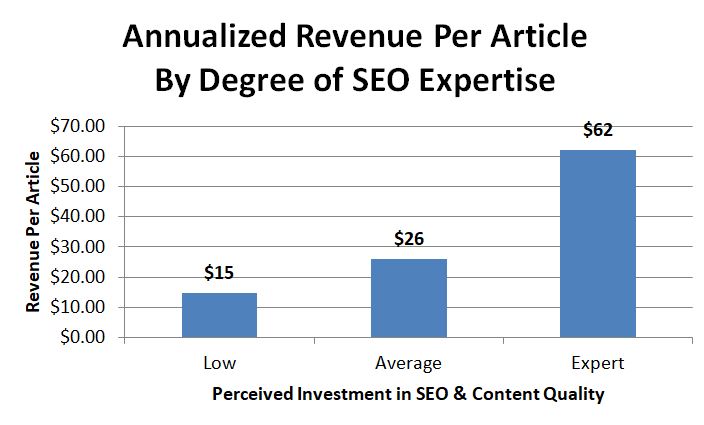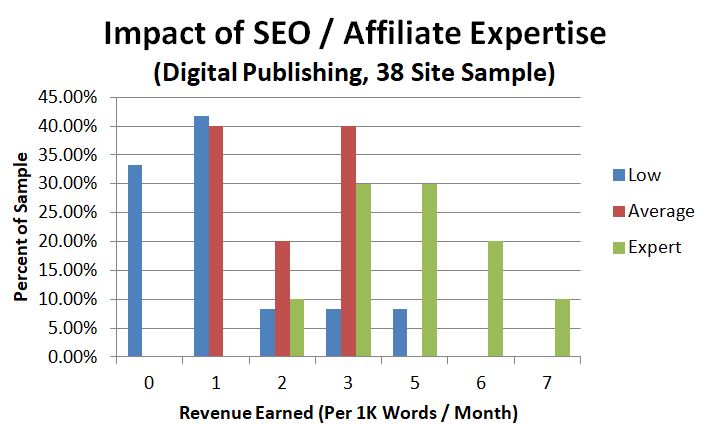If you’ve ever tried to buy content or SEO services, you’ve seen the big price swings. You can spend anywhere from $5 to $500 to publish an article on the internet.
Which begs the question: Is the extra expense of creating good content worth it?
As a website investor, this is a key strategy question. Content creation cost is not only our largest business expenses, it can take a year or more to earn back our investment. So should we buy a bunch of cheap articles or invest in good content and SEO tools?
Ask that question to any SEO or content agency and you’re going to get a bunch of hand waving. Vague references to “best practices”, the latest guru, or whatever the Google misinformation machine said this week. Or a carefully cherry picked case study of their best customer, which neatly buries their failures away from the public eye. Neither answer makes me feel comfortable about writing large checks.
When we did our own study of 38 websites recently listed for sale, we discovered that websites with better content / SEO earned more revenue per article. The data indicated websites run by “experts” earned 2.4 X more than average websites and 4.2 X more than websites with low quality content and search engine optimization.
For those who prefer a picture, here’s your chart:

Within the set of websites we looked at, the “expertly managed” websites generated an average of $62 per piece of “standard content” (1000 words) as compared with $15 for a lower quality website. Multiply this by three if you intend to flip the website or hold it as a long term investment:
The value of your work increases from $45 vs. $186, a $141 per article difference in profits.
Considering we’re only talking about investing another $15 – $50 per article to push your content up into the expert category, the upside starts to look compelling here…
Wait – How Did You Know They Were Experts?
As part of the sale process, sellers disclose statistics about a website. They also describe how the content was created and respond to buyer questions, frequently on a public comment thread.
Since these websites are being sold for cash flow, the seller has a powerful incentive to share information about how the content was created and ranked on Google. Investors look for this information to understand their level of risk and opportunity. Since many sellers own multiple websites and are active on social media, we could also see many of their other deals, Facebook posts, and their participation in other comment threads.
In the aggregate, this gave us between 250 and 2000 words of owner commentary for each deal about traffic, advertising, and content creation. Which was enough to make some judgement calls about their expertise. The people we assessed as “SEO experts“:
- Had a clear strategy for creating content and ranking the website
- Mentioned various statistics & data from high end paid SEO tools.
- Implemented high end ad networks or complicated affiliate offers.
- Were mindful of user experience and conversion rate optimization
- Consciously managed level of risk associated with their website
Lower quality webmasters tend to do the reverse. They sourced content from lower quality writing services, they only used free / cheap SEO tools, and they did not have access to higher paying ad networks or advanced affiliate programs. Their comments displayed limited perspective and sophistication about content and optimization.
Sites receiving an “average rating” were in the middle, generally displaying a strong understanding of the content and limited investment on turning it into a business. They were able to avoid the penalties associated with weak content but did not appear to benefit from the full value of their expertise.
By the way, given the diversity of views within the SEO community, we were almost completely agnostic with regards to how the owner got things done. We didn’t care what kind of hat they wore: white, black, gray, purple. The seller could have delivered an impassioned lecture about building churn and burn websites with a clear strategy to support their decision and we would have no option but to assess them as an expert.
It Gets Worse If You Focus on A Niche
One advantage of running a diversified publisher (like we do) is you’re not locked into any particular niche. Run out of high potential keywords about ferrets to write about? Fine, we’ll go write about hamsters for a few months. Or honey badgers. Google is our playground – just go pick another niche to work on. We can easily cherry pick projects.
Except – for most businesses, that isn’t how it works.
E-commerce, Service Providers, and SAAS have invested heavily in a single niche. Any content you write about should be related to your target market….
Sadly, that means you’re not chasing an infinite set of potential topics and keywords. You have a limited number of swings at bat – only a few well qualified prospects.
You can’t replace the lost opportunity from failure to rank and convert visitors. So that decline in performance is effectively a handicap on your total growth. Instead of getting 25% of the organic clicks for a search term, you get 2% of the traffic. Instead of converting 5% of your traffic, you convert 2%. Locking you into a lower growth rate.
How much is removing this barrier to your growth worth to you?
There’s Plenty of Upside
As the results below demonstrate, the expected monthly earnings of an individual website can vary dramatically. But investing in good content and a data-driven SEO strategy clearly bumps up the odds of getting a heavy winner in your portfolio.

Looking outside the sample used for this study, I’ve seen many privately held websites earn over $10 per article per month through building strong domain authority, affiliate marketing, and higher end advertising networks. Many of these websites have taken multiple passes at the same topic, using the lessons from each round of revisions to refine their focus. Website optimization is a powerful way to increase your returns.
There are three other things you should keep in mind here….
- Search engine traffic is usually recurring, so success is a gift that keeps on giving…
- While nothing lasts forever, great content survives longer than mediocre articles
- Well designed content can often be updated for a “second chance” at greatness
Is there a place for cheap content in your strategy? Certainly, there will be areas where this could certainly make sense. Particularly if you design and implement strong content creation processes to keep quality under control.
But in the long run, investing in excellent content is likely where the big money lies…

Great article.Thanks for your great information. The content are quite impressive.Any thoughts on the INK for All editor? INK guides you along with tips to up your content score. Obsessed with how it works. I like it better
Not bad for an entry-level tool – I’ve actually started using CanIRank for a lot of our optimization efforts; it’s a little bit more but does a much deeper dive into what Google is looking for in a search topic. It gave us a nice boost.